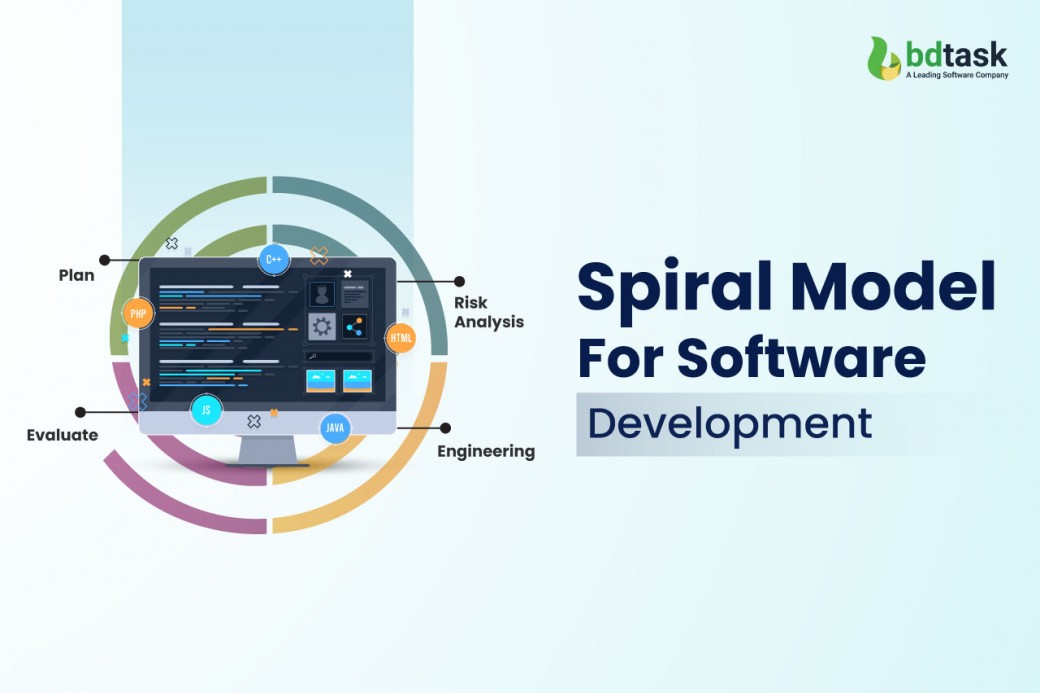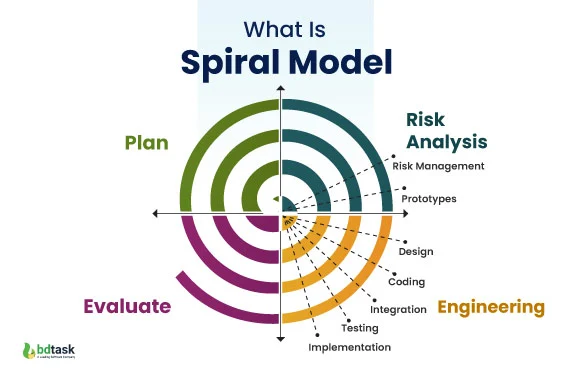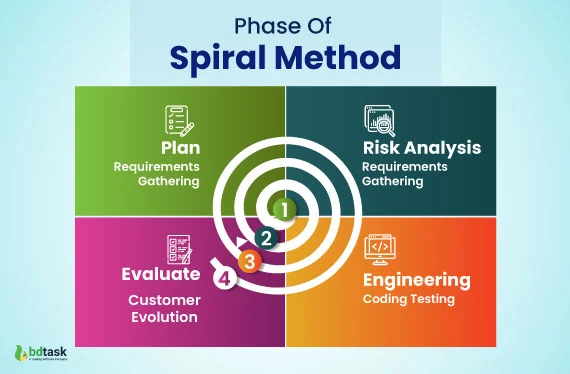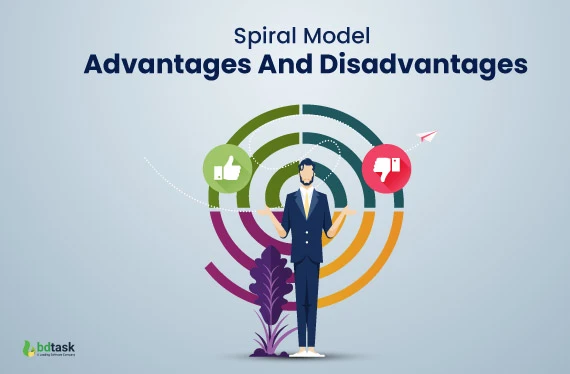Spiral Model For Software Development- A Risky-Driven Model

The spiral model for software development is the best-chosen software model for risky, extensive and complicated projects. The visual representation of this process looks like a spiral net with many loops. The number of loops depends on the project type and requirements. Each loop in the spiral model has four main phases of the software development process.
American software engineer Barry Boehm mentioned the spiral model in one of his papers, “Spiral Model of Software Development and Enhancement,” in 1986. The spiral method for the software development process combines the iterative development model and specific elements of the waterfall model for software engineering.
The spiral model for software development starts with collecting a small set of requirements and goes through a small development phase. Unlike the waterfall model, the spiral model can add functionality at any increasing spiral phase.

What Is Spiral Model For Software Development?
The Spiral model for software development combines elements of iterative and incremental development methodologies. This combination allows flexibility and adaptation as a project progresses.
In 1986, Barry Boehm initially proposed the spiral model. He established it as a well-suited model for large and complex projects. The Spiral Model is characterized by its emphasis on risk analysis and management throughout the software development lifecycle. It consists of four phases that are executed in a cyclic or spiral fashion. Each iteration of the Spiral model is referred to as a "spiral."
Four phases of Spiral model for software development are:
- Planning
- Risk Analysis
- Engineering
- Evaluation

Phase Of Spiral Model Software Development Life Cycle
The spiral model for software development follows the four phases which help to gather data, manage risk, design, review and deploy software. Each phase holds specific significance for software development. In this section, we will discuss the activities of each phase and how they impact the total software development journey.
1. Planning (Requirement Gathering)
Just like any other model like SDLC Agile model, V-shape model, and waterfall model, spiral model SDLC also follows the planning phase very significantly.
The primary purpose of the planning phase in the spiral model SDLC is to collect, understand and identify the core objectives and set some alternative solutions.
Moreover, it also gathers elaborative details of every small requirement. Graphically, the planning phase of the spiral method of software development starts from the baseline spiral. As the software development progresses, it creates a prototype of software, plans alternative solutions and finalizes the list of changes.
2. Risk Analysis (Risk Management)
In this phase of the spiral model for software development, the developer term will identify all the potential risks that will arise during the software development process.
After the developer is done with problem identification, the software engineer will plan a list of strategies to mitigate the risks. In short, this phase is all about risk management along with the technical feasibility.
After the risk identification process, the developer team will release a prototype, which will be a risk-free demographic version of the software. Not only will the developer release a risk-free prototype, but they also will plan alternative solutions to handle the risk.
3. Engineering (Designing and Coding Phase)
This phase starts with designing the leading software by idolizing the prototyped design from the baseline spiral. The prototype design will be a guideline for software architecture, logic, front-end and final design.
After the software engineering is done designing the software, they will start coding, testing and the deployment process. Moreover, developers will deploy the software on the client’s site to gather feedback. This phase in the spiral model is totally technical and needs experience and expertise to tackle any challenge or change.
4. Evaluate (Review And Deployment)
After the launch of a software project on the client’s site, the client is open to sharing feedback and insightful observations about the software.
Hence, the testing team from the client side will note down all the feedback, observations, additions and changes needed in the software or its functionality. All the correction lists will be sent to the development team,
Again, a new baseline will begin to fix all the bugs, and after fixation of all requirements, the final product will be ready for final launch.

Spiral Model Advantages And Disadvantages
Even though there are several software development life cycle models, the spiral model is best for handling large and complicated software development projects. But there are still some significant advantages and disadvantages of the spiral model, which we have to face while in the development process.
Advantages Of Spiral Model
- Best Model To Handle Risky Projects: It is very common that many unknown risks arise through a software development process. As the spiral model can address the rising issues and reduce the impacts of uncertainty, it is the perfect pick for a risky project.
- Good Choice For Large Projects: All the SDLC methods are not suitable for big projects. But, any large and complex projects can be handled in the best way using the spiral model.
- Flexible With Requirements: The spiral model is adaptable to any changes or additions at any phase and any time of a software development journey.
- Better Customer Satisfaction: The client can overview during the early phase of the software development process where the spiral method is used. It helps to create the best customer-friendly software before launching the final stage.
- Iterative and incremental approach: The spiral model follows a sequential combination of repetitive and incremental models in software development. It creates the opportunity to make corrections and be more efficient during software development.
- Open to receiving any feedback: The spiral model appreciates regular evaluation of a software project. So, there is a big opportunity to improve the software during the development process.
- Better quality: You will get an improved quality outcome because of the multiple repetitions for every development phase in the whole software development life cycle.
Disadvantages Of Spiral Method
- Complexity: The spiral model for software development is comparatively more complex than other SDLC methods.
- Expensive: The spiral method requires more budget than other SDLC methods. So, in normal cases, it is not suitable for small or medium size software projects. Usually, tech enterprises conduct in spiral software development within global captive centers, ODCs and other investment-heavy and long-term collaboration-oriented facilities.
- Too much dependency on experts: The spiral method is expert-dependent. How much the project will be successful depends on the risk analysis and experience of the expert developers.
- Poor time management: Spiral models have an unknown number of phases; therefore, it is complicated to track the software project deadline.
- Follows multiple iterations: As the spiral method involves multiple repetitions, many developers consider this an irritating process.
- Time-consuming: Spiral methodology goes through multiple recurrences, feedback and changes during the development process. So, it becomes a time-consuming process to finish the software project.
- Require intensive investment: Spiral method handles threat-oriented software projects and hence requires a significant amount of investment in planning, risk analysis and evaluation.
Risk Handling In Spiral Model For Software Development
Indeed, the spiral methodology is best for handling risky projects, but it still has to face severe challenges to correct the changes. Any risk in a software project might affect the development progress.
The spiral model follows in developing a software prototype earlier before going to the coding phase of software design. Hence, it is easier to solve the maximum risks in the “risk analysis phase“.
Even though we all expect the bugs or faults to be solved before the software prototype, in reality, project risk rises when developers actually start developing the software.
All of this risk management hassle will get solved flexibly only because of this spiral model. According to the spiral model, through building software prototypes, every feature is analyzed and tested, fixed the bugs and solved the identified changes.
When To Use The Spiral Model Phase?
The spiral model for software development is usually known for handling risk-oriented, large, expensive and complicated projects. The spiral model is the most used SDLC process since it automatically synchronizes with the natural software development lifecycle process. Below, I have mentioned project types that are perfect for using the spiral model phase.
- Handles medium to high-risk project
- Project requirements are unclear and complex
- Changes can be made at any phase of the project
- When prototype creation is mandatory
- Not at all feasible for long project commitment
- Project release is frequent
- Risk mitigation and cost evaluation is crucial
The Spiral Model for software development addresses the inherent uncertainties and complexities of modern software projects. Its cyclic nature, combining planning, design, implementation and testing, allows for continuous refinement and adaptation to changing requirements and risks. This software development life cycle (SDLC) method encourages transparency, collaboration and the delivery of high-quality software products.
Though it is one of the best SDLC methods, it is not suitable for every project. But, for the project where uncertainty and evolving requirements are needed, you can use the spiral model without any doubt.
Best of luck for your next software development using spiral model.











